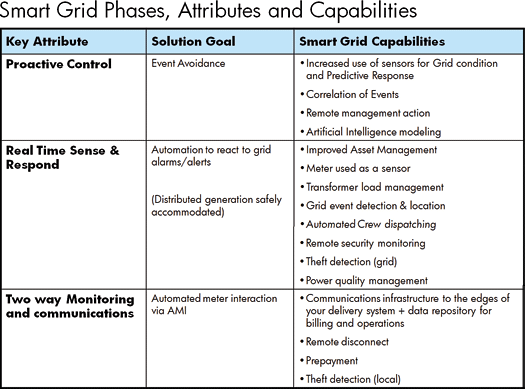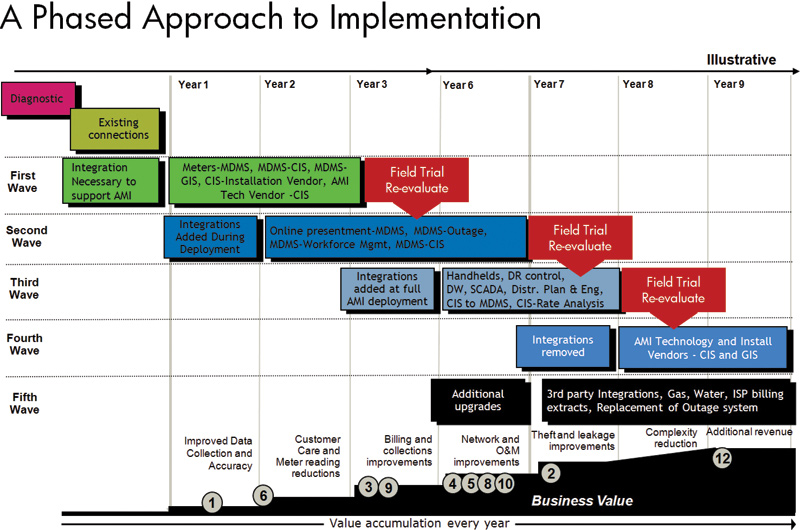The utility industry is at a crossroads and the introduction of smart grid technology introduces disruptive effects. Governments are mandating more open and competitive markets, requiring new smart meter technology to conserve energy, and demanding more reliable security of supply. There is an increased pressure to reduce the massive energy carbon footprint and provide more renewable sources for energy. Technology modernization is opening the door for intelligent grids backed by new world information systems that demand more information exchange than ever before. An increasing move to de-regulated competitive markets, and the introduction of new players, is placing new demands on established utilities companies.
The Challenge of Connected Intelligence
To gain competitive service advantage in the face of new customer and constituent patterns requires that technology be at the very forefront of enterprise innovation and growth. Tomorrow’s leaders will be organizations that embed technology in everything they do. For utilities, this means smart grid service management, service oriented architecture (SOA) and ‘connected intelligence’. This will enable them to capitalize-on, rather than simply adapt-to, customer expectations.
The Power of the Smart Grid
The promise of the smart grid is in the data and power it holds to transform the relationship between consumers and utilities. Vast amounts of granular consumption data have been made available. This explosion of information requires a solid plan for its management, maintenance and usage.
Properly handled, data analysis can open the door to new markets, new services and new lines of business. In a smart grid, the end-point network devices don’t just gather data. They communicate vital information to provide a deeper understanding about supply and demand. Providing consumers with detailed information on appliance performance and energy management services can help consumers conserve and save, as well as funnel important usage information back to the enterprise.
From the outset of any smart grid program, utilities should plan on enhancing the analytics environment or building a strong information optimization strategy that harnesses data and delivers it in the right context for the business.
Customer-Centric Focus
To succeed in this environment, utilities need to become more customer-centric, offering new services that bring value.
Utility companies must serve customers, employees, partners and citizens with whatever they want and need, instantly, at any point in time and through any channel. They must use technology to integrate and automate the value chain. It adapts easily and innovates rapidly; it manages risk and environmental responsibilities.
Home Area Networks (HANs) will evolve to integrate the customer experience in the home with components that send and receive real-time information from utility and third-party providers. Additionally, Internet access will provide a secure utility portal to monitor and compare detailed energy consumption. And, as smart grid technology moves from concept to implementation, the utility-customer relationship will fundamentally change. Customers will have newfound tools and information to help utilities drastically reduce demand spikes and drive energy conservation. Monthly paper bills and outage calls will be things of the past. The customer of tomorrow will demand daily, if not hourly, interaction with their utility provider.
Lessons Learned from the Telecommunications Industry
The utilities industry’s transition to smart grid will be as dramatic as the shift from landlines to mobile phones was for the telecommunications industry. There are several lessons that can be applied from one industry to the other.
This shift requires changing the current approach to provisioning energy (and other resource) infrastructure, to one that concentrates on empowered consumers. This is not an easy task, but utilities have the opportunity to learn from the telecommunications industry. Over the past two decades, telcos have moved to a customer-centric business model, having navigated similar challenges to those now facing the utility industry. Key lessons and best practices in service management, connected intelligence and service oriented architecture apply.
Grid Service Management
One of the key issues facing utilities is the service management of the grid. Today’s distribution networks have little to no form of network supervision or management. As smart meters are rolled out, the suppliers are focused on data output and management from the meters. However, the smart meter will also provide an important sensor point at the end of the network.
By applying advanced networking tools and business analytics, events and alarms emanating from the intelligent networks are correlated and provide key information that will positively influence security of supply and customer satisfaction. Today’s smart meters deliver advanced capabilities to monitor multiple types of energy usage in defined time periods. In addition, smart meters come equipped with a multitude of communications technologies, allowing them to share data and receive command and control signals from the utility company. LAN and WAN communications enable smart grids to cover diverse geographical areas.
However, as smart meters, low cost sensors, and other devices that communicate over the network become pervasive on grids, utilities will have the added challenge of managing tens or even hundreds of millions of devices just as the telecommunications industry has implemented provisioned solutions to manage the real-time networks of millions of mobile phones.
Smart Grid Maturity
Most utilities’ major systems environments were designed 20 or 30 years ago when the primary objective was reliability and simplicity. These legacy systems require significant modification to handle the granularity, volume and timeliness of new data when integrated with new smart grid-specific systems. Therefore, it is critical to identify the primary objective of a smart grid project upfront to achieve the appropriate level of smart grid maturity. Simply securing cost savings through automated meter readings is very different from implementing AMI to enhance customer relations and conservation capabilities. Smart grid vision and maturity evolves in stages that build upon one another.

The key attributes to smart grid maturity include: proactive control, real-time sense and respond, and 2-way monitoring and communications.
The key attributes to smart grid maturity include: proactive control, real-time sense and respond, and 2-way monitoring and communications.
The first phase of smart grid maturity introduces communications into metering. Digital application and implementation kick off as prices drop and performance improves. In time, automated reading systems are able to gather time-based electric consumption information and deliver granular information to the utility without reading meters on-site.
In the next phase, AMI improves communications considerably, giving more information to the utility and sending it from the utility back to the meter on an individual basis to control the meter.
The third phase of smart grid maturity includes bi-directional device communication applied to customers and devices in electric grids, including wires, transformers and switching stations. All network devices deliver consumption information and how the network is responding. This empowers utilities to adjust network operations and optimize power delivery.
Service Oriented Architecture
Service oriented architectures (SOAs) are ideal for smart grid service management because they allow complex components to be integrated, as well as solutions to be built and implemented on a timeframe that suits the business. SOAs are modular and scalable, allowing an incremental approach to smart grid deployment that supports the reliability utilities require.
Architecture must drive interoperability between solutions and related consistency in operations because it defines how components will interrelate and integrate. As smart grid solutions continue to evolve and change, SOAs enable utilities to regularly re-validate components throughout proposal, build and deployment stages. As such, the architecture-based approach provides critical future-proofing and investment protection.
The SOA approach is logical and simple and gives flexibility to enhance the solution without deep-routed changes.
Utilities must avoid a too-large, big bang implementation, as unmanageability could risk a disruption in service. Because they represent a truly fundamental change, smart grid implementations are too large and complex to be handled all at once. Smaller packages of change will minimize risks and empower the utility to start reaping rewards incrementally.

As the example below indicates, utilities should lay out tangible and familiar smart meter implementation components, and define the correlation to common IT operational processes. This provides a view of how smart grid components will impact the IT areas, and beyond to operational support, rolling trucks in the field and customer service.
For example, many utilities realize the benefits of automated meter reading relatively early in the process while more complex functionality (e.g., pre-payment, load limiting or distributed generation) will yield the most benefit when applied to larger domains. Opting for a phased approach minimizes project risk and maximizes time value of benefits through an interconnected series of changes.
Connected Intelligence
Capacity planning is a core service management area where utilities can avoid missteps on their journey to smart grid. Having built network-based data storage systems independently of the business model and the operational and customer information, telecoms are now struggling to break out from this curtailing structure. Utilities must embrace this need for long-term planning. By building enterprise data warehouses, they will be able to plan for the increasing demand by providing “connected intelligence” across the whole supply chain.
Managing the grid according to anticipated demand will be instrumental. The prevalence of digital technologies being applied to the grid and other disruptive influences such as electric vehicles (EV) and micro-generation are bound to change the dynamics of the grid. EV drivers will want to recharge their cars at a time that is convenient for them. Unless this is carefully managed, peak loads might be exacerbated.
As EV users are also likely to want to recharge at various locations there will be a requirement for utilities to reconcile these ‘roaming charges’ to consumers’ home electricity bills. Once again, utilities can look to the telecommunications industry for a successful model in roaming and the consolidation of billing of customers’ charges to their personal telecom bills.
Looking Ahead
Only a collaborative and open approach between utilities, vendors, partners, industry groups, regulatory bodies and the government will prove overall successful. Utilities should not take an introspective approach. Utilities should actively involve themselves with these groups to glean best practices on technology solutions, business models, regulatory approaches, financial justifications and customer marketing as well as communications. Grid service management can provide a common-sense approach which will ensure they are on the right track in developing a clear vision of future business requirements, which will help them avoid unnecessary pitfalls and investments on their path to success.
About the Authors

Ian Mitton is the HP Enterprise Business worldwide director for the Utilities Industry. His role includes developing HP Enterprise Business’s global strategy and overseeing the creation of industry specific solutions that incorporate the company’s broad portfolio of services and software. Mitton has been involved with the energy industry since 1999 and his responsibilities over that time have included seven years as a global client business manager for Shell, building relationships at the most senior levels and assisting Shell to align IT with their business strategy. More recently, Mitton was the business development manager for HP Enterprise Business’s Energy and Distribution Industries vertical in Europe, the Middle East and Africa.

Roy Pratt is the chief technology officer for the Energy Industry Utilities practice in HP’s Enterprise Services division. Pratt leads utilities portfolio integration, innovation, technical solutions, delivery oversight and Smart Grid consulting activities. He provides executive level analysis, recommendations, and hands-on guidance for major infrastructure and application technology implementations throughout the energy industry. As CTO, Pratt has provided enterprise integration strategies, AMI and Smart Grid architectures, and implementation solutions for numerous utility companies. Pratt has over 25 years of experience in the manufacturing, engineering, process control, SCADA, communications, oil and gas, and utilities industries. He actively develops industry alliances with strategic partners and participates in industry associations.








